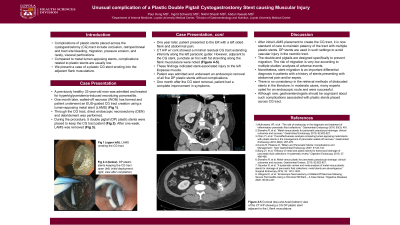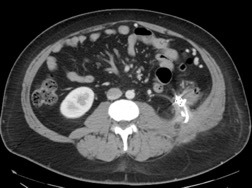Back


Poster Session B - Monday Morning
Category: Interventional Endoscopy
B0478 - Unusual Complication of a Plastic Double Pigtail Cystogastrostomy Stent Causing Muscular Injury
Monday, October 24, 2022
10:00 AM – 12:00 PM ET
Location: Crown Ballroom

Has Audio

Paul P. Hong, MD
Loyola University Medical Center
Maywood, IL
Presenting Author(s)
Abdul Haseeb, MD, Paul P. Hong, MD, Ingrid Beyruth Schwartz, MD, Nikhil Shastri, MD
Loyola University Medical Center, Maywood, IL
Introduction: Complications of plastic stents placed across the cystogastrostomy tract include occlusion, retroperitoneal and tract site bleeding, migration, pressure erosion, and rarely, visceral perforations. Compared to metal lumen apposing stents, complications related to plastic stents are usually low. We present a case of a plastic cystogastrostomy stent eroding into the adjacent flank musculature.
Case Description/Methods: A previously healthy 33-year-old man was admitted and treated for hypertriglyceridemia-induced necrotizing pancreatitis. One month later, patient underwent an EUS-guided cystogastrostomy (CG) tract creation using a 15 mm x 10 mm lumen-apposing metal stent (LAMS) for drainage of retroperitoneal walled-off necrosis cavity. He had three more necrosectomies over 4 weeks with complete necrotic removal. At the conclusion, five 10 French double-pig-tail (DP) plastic stents were placed to maintain patency of the CG tract.
One year later, patient presented to the ER with left sided flank pain radiating to the inguinal region associated with nausea and vomiting. CT of the abdomen and pelvis with IV contrast was obtained: it showed a minimal residual CG tract extending inferiorly along the left paracolic gutter. However, adjacent to the CG stent punctate air foci with fat stranding along the flank musculature were noted (Figure 1-2). These findings indicated stent associated injury to the left iliopsoas muscle. Patient was admitted and underwent an endoscopic removal of all five DP plastic stents without complications. One month after the CG stent removal, patient presented at the follow-up visit with complete improvement in symptoms.
Discussion: After initial lumen apposing metal stent placement to create cystgastrostomy tract, it is now standard of care to maintain patency of the tract with multiple plastic stents. Double pig-tail stents are used in such settings to avoid vascular injury in the necrotic tract. In our case, a DP plastic stent is attributed to causing a direct injury to the iliopsoas muscle. Although rare, gastroenterologists should be cognizant about such complications associated with plastic stents placed across cystgastrostomy tract.

Disclosures:
Abdul Haseeb, MD, Paul P. Hong, MD, Ingrid Beyruth Schwartz, MD, Nikhil Shastri, MD. B0478 - Unusual Complication of a Plastic Double Pigtail Cystogastrostomy Stent Causing Muscular Injury, ACG 2022 Annual Scientific Meeting Abstracts. Charlotte, NC: American College of Gastroenterology.
Loyola University Medical Center, Maywood, IL
Introduction: Complications of plastic stents placed across the cystogastrostomy tract include occlusion, retroperitoneal and tract site bleeding, migration, pressure erosion, and rarely, visceral perforations. Compared to metal lumen apposing stents, complications related to plastic stents are usually low. We present a case of a plastic cystogastrostomy stent eroding into the adjacent flank musculature.
Case Description/Methods: A previously healthy 33-year-old man was admitted and treated for hypertriglyceridemia-induced necrotizing pancreatitis. One month later, patient underwent an EUS-guided cystogastrostomy (CG) tract creation using a 15 mm x 10 mm lumen-apposing metal stent (LAMS) for drainage of retroperitoneal walled-off necrosis cavity. He had three more necrosectomies over 4 weeks with complete necrotic removal. At the conclusion, five 10 French double-pig-tail (DP) plastic stents were placed to maintain patency of the CG tract.
One year later, patient presented to the ER with left sided flank pain radiating to the inguinal region associated with nausea and vomiting. CT of the abdomen and pelvis with IV contrast was obtained: it showed a minimal residual CG tract extending inferiorly along the left paracolic gutter. However, adjacent to the CG stent punctate air foci with fat stranding along the flank musculature were noted (Figure 1-2). These findings indicated stent associated injury to the left iliopsoas muscle. Patient was admitted and underwent an endoscopic removal of all five DP plastic stents without complications. One month after the CG stent removal, patient presented at the follow-up visit with complete improvement in symptoms.
Discussion: After initial lumen apposing metal stent placement to create cystgastrostomy tract, it is now standard of care to maintain patency of the tract with multiple plastic stents. Double pig-tail stents are used in such settings to avoid vascular injury in the necrotic tract. In our case, a DP plastic stent is attributed to causing a direct injury to the iliopsoas muscle. Although rare, gastroenterologists should be cognizant about such complications associated with plastic stents placed across cystgastrostomy tract.

Figure: Axial view of the CT abdomen/pelvis showing a CG DP plastic stent adjacent to the L flank musculature.
Disclosures:
Abdul Haseeb indicated no relevant financial relationships.
Paul Hong indicated no relevant financial relationships.
Ingrid Beyruth Schwartz indicated no relevant financial relationships.
Nikhil Shastri indicated no relevant financial relationships.
Abdul Haseeb, MD, Paul P. Hong, MD, Ingrid Beyruth Schwartz, MD, Nikhil Shastri, MD. B0478 - Unusual Complication of a Plastic Double Pigtail Cystogastrostomy Stent Causing Muscular Injury, ACG 2022 Annual Scientific Meeting Abstracts. Charlotte, NC: American College of Gastroenterology.
